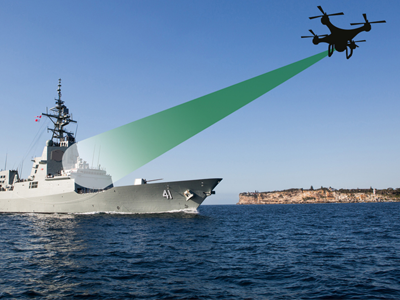Shining a light on our maritime science at PACIFIC 2019

Above, on the surface and in the depths of the ocean - we're there.
DST’s support to Defence’s maritime activities will be highlighted on our stand at the PACIFIC 2019 conference in Sydney this month.
Each segment in DST’s circular stand at PACIFIC highlights one of the five major S&T focus areas defined in our Maritime Domain S&T Strategic Plan 2016-2026, with a sixth segment bringing it all together in the form of the challenging enhanced undersea surveillance STaR Shot.
The maritime S&T focus areas are:
Joint and Combined Maritime Operations
DST is undertaking operations research, modelling and analysis to support Navy ‘s objective to generate and deploy flexible, scalable, self-supported and sustainable maritime task groups capable of accomplishing the full spectrum of maritime operations. Examples from this area highlighted at PACIFIC 2019 include the SHORE operations research simulation environment, the latest developments in underwater automatic target recognition, and DST’s maritime capability analysis process.
Decision Superiority
DST is supporting Navy’s goal of achieving decision superiority through the synchronisation and integration of its operations, intelligence and communications capabilities to generate information effects. Decision superiority is the ability to make and implement more informed and accurate decisions at a rate faster than the adversary. It enables the Commander to determine if, when and how engagements occur. Examples from this area highlighted at PACIFIC 2019 include exploration of maritime tactical drone integration, research that is improving and exploiting environmental modelling, and teams using the latest human sciences to explore undersea command and control concepts.
Mission Survivability
DST is providing advice on the susceptibility, vulnerability and recoverability of Navy platforms, in order to help Navy maximise the survivability of its platforms, systems and people. The use of layered defence towards this goal is vital. By understanding both offensive and defensive systems, defence scientists can provide guidance on ways to develop systems and tactics to enhance survivability. Examples from this area highlighted at PACIFIC 2019 include autonomous undersea sensors, a drone-based tool to generate 3D laser-scanned images of maritime platforms, and innovative hydrodynamics science.
Creating and Shaping the Future Force
DST is supporting the future needs of Navy by delivering science based technology foresight and forecasting to safeguard against emerging and disruptive technologies, and through capability assessments and gap analysis. By looking into the future, defence scientists will ensure that the Future Navy is equipped, supported and enabled to fight and win at sea in the future operating environment. Our defence scientists working in this area use modelling and simulation to explore surface ship and submarine platform concepts and requirements.
Seaworthy and Airworthy Fleet
DST continues to provide S&T support at all stages of the capability life cycle to provide assurance that the current and future Navy fleet of ships, submarines and helicopters is fit for purpose and sustainable for all future missions. DST’s contributions here include analysis of helicopter and drone launch limits from ship decks, anti-biofouling systems for the protection of maritime assets.
During PACIFIC, nine of our defence scientists will be pitching our technologies that have opportunities for collaboration. Come and visit us at our stand to talk to the experts and learn about Australia’s exciting maritime defence science achievements.

